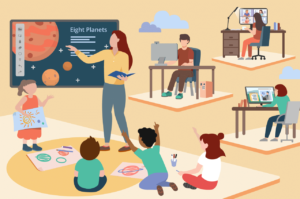
Generative AI has become an indispensable part of my life now. Thinking from waking up to sleeping, it fits in our life in such a way that we become so dependent on it. As an Educator at BYJU’s, I have experience of using various AI tools like copilot, chatGPT to craft my insights for our educational website. With these AI tools I have solved various challenges in the education sector like reducing the cost of textbooks which were not affordable by people or making education easily accessible for all which was a barrier in learning for students. I have witnessed the power of technology in providing high quality education and making it accessible for all. AI plays an essential role in fostering inclusive education by promoting personalized learning and providing equal access for underserved communities. AI has helped me alot to identify the sensitive issues like girl education and reinforcing equitable education by considering the societal needs of individuals. Also, AI was successful in providing real time solutions for various challenges which came in our way to promote inclusive education.

AI has become an important part of my personal life. I am using various health related AI tools to monitor my healthy lifestyle and it motivates me to achieve fitness goals. Apart from health, these AI tools have been very supportive in performing my hobbies like exploring new things and photography. I get inspired from the ideas AI provides and these unique ideas help me to engage more in my hobbies.
If I think about the benefits of AI then I would say it organizes our tasks and enhances creativity and efficiency. AI helps me to think critically and solves many problems of mine. However, there are some disadvantages like we are getting over relied on AI for even simple work day by day. Additionally, I am concerned about my personal data whether it is safe or not.
Despite challenges, I believe AI has a bright future and has the potential to transform the different sectors like healthcare, education or entertainment. AI is incredibly responsible in making my journey interesting and full of experiences.



 Assistive technology has a significant impact in transforming my teaching methodology. When I was working with the Pravah Organisation in New Delhi, India, and the National Trust for the Welfare of People with Autism, Cerebral Palsy, Mental Retardation, and Multiple Disabilities, I was deeply involved in creating awareness among people about the importance of inclusive education and integrating it with the assistive technology. I was pretty sure that this would definitely change the lives of the individuals with disabilities and would lead to a more equitable community. While moving forward in my journey, I faced a few challenges and experiences which I would like to address.
Assistive technology has a significant impact in transforming my teaching methodology. When I was working with the Pravah Organisation in New Delhi, India, and the National Trust for the Welfare of People with Autism, Cerebral Palsy, Mental Retardation, and Multiple Disabilities, I was deeply involved in creating awareness among people about the importance of inclusive education and integrating it with the assistive technology. I was pretty sure that this would definitely change the lives of the individuals with disabilities and would lead to a more equitable community. While moving forward in my journey, I faced a few challenges and experiences which I would like to address.

 and approachable for every student and teacher regardless of their backgrounds.
and approachable for every student and teacher regardless of their backgrounds. Teaching has always been my passion. To meet the diverse needs of my students and make my teaching more engaging, I am motivated to incorporate various useful tools into my teaching pedagogy. I believe, with digital tools the online and blended learning experience becomes more dynamic and equitable and makes sure that every student should get an equal opportunity to succeed in their life. All these tools have become the lifelines in our education system.
Teaching has always been my passion. To meet the diverse needs of my students and make my teaching more engaging, I am motivated to incorporate various useful tools into my teaching pedagogy. I believe, with digital tools the online and blended learning experience becomes more dynamic and equitable and makes sure that every student should get an equal opportunity to succeed in their life. All these tools have become the lifelines in our education system. 



